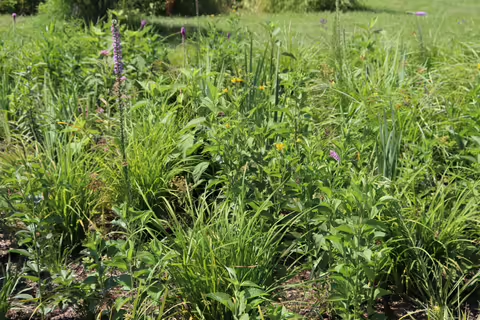URBANA, Ill. – Retailer shortages of the most popular native perennial plants were common this spring as there was an unprecedented run on supplies. But fall is another great opportunity to plant, says Austin Little, University of Illinois Extension horticulture educator.
Herbaceous natives like butterfly milkweed or echinacea from transplants can be planted in the spring. However, Little says planting in fall has a few more benefits, such as improved establishment and flowering in the following spring, better vigor, and greater weed suppression..
Native plants are a critical part of our ecosystems and contribute to beneficial insects, birds, wildlife and important microorganisms living in and on soils.
In the fall, soils hold onto heat longer even as above-ground temperatures are dropping, which is ideal for new root structures to grow. The root systems need time to establish new micro or feeder roots which helps the transplant to acclimate, then gradually go into dormancy as colder winter temperatures arrive. Fall transplants have better root structure and more time to acclimate to the local environment.
Herbaceous native perennials transplants or seeds can be ordered online or from a local nursery. Plugs are easier to plant and establish quicker. They need to be planted about six weeks before the first frost of fall. In Southern Illinois, the first frost date is historically in the last two weeks of October. Northern Illinois is a week or two sooner than that, so be sure not to plant too close to the first frost.
“If direct seeding, wait until the first hard frost to apply the seed to a weed-free bed with open soil so the seedlings do not germinate prematurely,” Little says. “Most native herbaceous perennials have very small seeds and need only a thin layer of soil and mulch to undergo the chilling process known as stratification.”
Transplants need to be thoroughly watered when they are installed. To encourage deeper root growth, it’s better to water less often but more deeply, once or twice a week for about 30 minutes depending on rain and temperature. When it’s getting close to the average first frost date, Little says it’s a good idea to back off on the water.
“Even if it warms up a bit in late fall, it’s best to hold off on watering to avoid interrupting the hardening off process,” he says.
Fertilizing in the fall is not recommended. Many native herbaceous plants are adapted to lean and low fertility soils. Adding nitrogen and other nutrients in the fall may cause the transplant to put energy into new vegetative growth that will be damaged by winter conditions and suppress the establishment of roots. Hold off on fertilizing until early spring, Little recommends
Do add a 2- to 3-inch layer of mulch or compost around the base of plants, making sure to leave some open space around the stems to avoid harboring unwanted pests and moisture build up. Fall plants don’t need to be mulched immediately after planting and can benefit from the sun warming the soil. Mulching can wait until night-time temperatures are in the 32°F range. By adding mulch, such as straw or finely shredded hardwood wood, and making sure plants are well anchored in the soil, frost heaving can be avoided.
Adding fall compost around any new plants is also recommended. By spring, most of the compost will be broken down and ready to be taken up by plants with root structures that have a head start on spring transplants.
Tips for fall planting native perennials
- Order and buy plants with enough time to plant six weeks ahead of the first frost.
- Water deeply once or twice a week, then stop watering after the first hard freeze.
- Help overwinter fall transplants with mulch and compost.
- Do not fertilize new transplants until spring.
SOURCE: Austin Little, Horticulture Educator, Illinois Extension
ABOUT EXTENSION: Illinois Extension leads public outreach for University of Illinois by translating research into action plans that allow Illinois families, businesses, and community leaders to solve problems, make informed decisions, and adapt to changes and opportunities.
PHOTO ACCESS: The photo in this article is available to download for media use.
